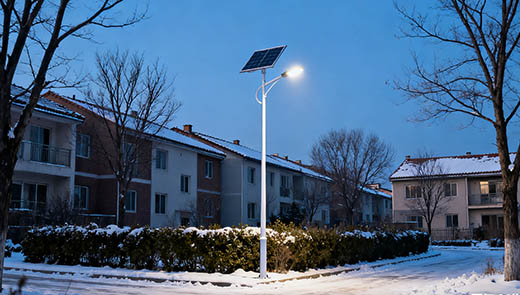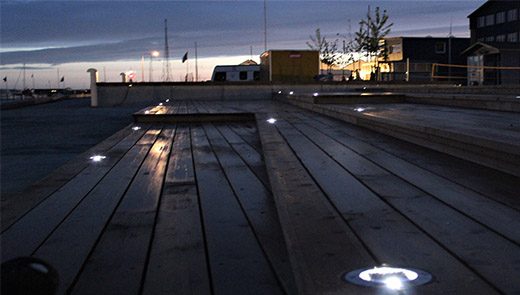Top Features to Look for in a Solar Street Light Manufacturer
Against the backdrop of energy transition and green development, solar street lights have gained widespread adoption across municipal roads, commercial complexes, and rural infrastructure due to their low-carbon, energy-efficient, and wiring-free advantages. They have become essential facilities driving sustainable construction. Selecting a high-quality solar street light manufacturer directly impacts product lifespan, long-term operational costs, and even determines whether a project achieves its intended lighting outcomes. Choosing the wrong partner may lead to project rework, prolonged losses, and other issues. This article provides a detailed analysis of six core characteristics for evaluating manufacturers, helping you identify suitable partners that meet your needs and ensuring the efficient advancement of your solar LED street light projects.
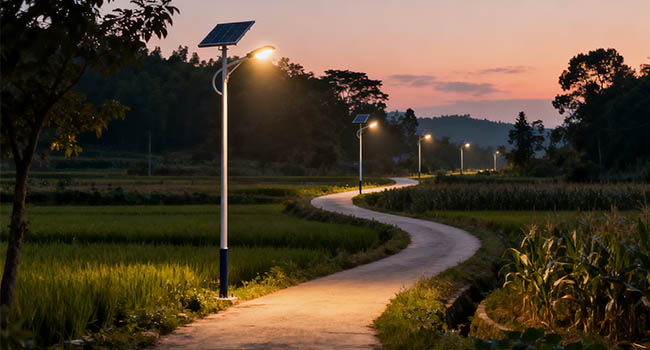
Quality and Reliability
The Foundational Role of High-Quality Materials and Components
Exposed to harsh outdoor conditions like heavy rain, extreme heat, freezing temperatures, and strong winds, the durability of solar street lights hinges on the quality of materials and components used by manufacturers. Prioritize suppliers employing high-transmittance tempered glass solar panels, corrosion-resistant hot-dip galvanized steel poles, and high-capacity, long-life lithium batteries. This ensures stable performance and reduced maintenance frequency due to component aging over extended use. Additionally, verify whether manufacturers implement rigorous material procurement control processes and incoming inspection mechanisms to ensure quality from the source.
Significance of Authoritative Certifications in Quality Assurance
ISO 9001 Quality Management System certification and CE compliance certification serve as crucial benchmarks for evaluating a manufacturer's quality control capabilities. The former indicates that the manufacturer adheres to clear standards throughout every stage—from design and production to inspection—ensuring consistent production quality for solar street lights. The latter certifies compliance with EU safety, health, and environmental regulations, ensuring the safety and regulatory adherence of solar LED street lights.
The Value of Customer Reviews and Reputation Research
Customer reviews and reputation provide genuine feedback on a manufacturer's solar street light product quality and service level. Collect customer reviews and testimonials through industry forums, professional procurement platforms, social media, and other channels. Focus on customer assessments of fault frequency, maintenance response times, and long-term usage experiences. For instance, note if any customer reports that “battery endurance significantly declines after one year of using solar LED street lights.” Additionally, contact peer companies to obtain firsthand feedback, comprehensively understanding the manufacturer's reputation to avoid being misled by false advertising.
Customization Options
Tailored Product Parameters for Project-Specific Requirements
Each solar street light project demands distinct usage scenarios, lighting conditions, and illumination needs. Municipal thoroughfares require high-brightness, long-endurance solar LED lights, while residential pathways need low-brightness, soft-light solutions. A manufacturer's ability to customize parameters is crucial. Select manufacturers offering flexible adjustments for solar panel power (100W-300W), battery capacity (50Ah-200Ah), and light output (500lm-5000lm). This ensures precise alignment with project requirements—for instance, higher-power panels and larger batteries can be customized for regions with insufficient sunlight.
Design and Brand Customization Enhance Overall Project Cohesion
Beyond core specifications, integrating solar street light aesthetics and brand elements elevates visual consistency and brand recognition. Premium manufacturers offer customizable aesthetics, including solar LED pole styles (minimalist modern, vintage Chinese, etc.) and colors (gray, black, wood grain finishes, etc.), ensuring alignment with project themes like scenic areas' natural aesthetics or commercial complexes' tech-forward designs. Additionally, brand customizable manufacturers can imprint client logos on lamp bodies or poles, transforming solar lights into project “visual symbols.”
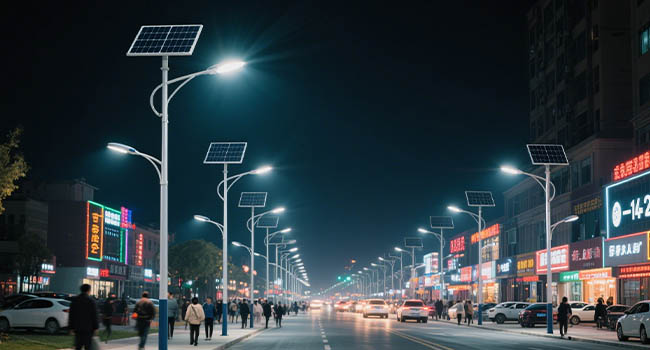
Energy Efficiency
The Critical Role of High-Efficiency Components in Energy Utilization
The core advantage of solar street lights lies in harnessing renewable energy, with high-efficiency components forming the foundation for optimal energy utilization. Prioritizing manufacturers that employ high-conversion-efficiency solar panels (e.g., monocrystalline silicon panels with conversion efficiency ≥22%) and low-power, high-brightness LED light sources maximizes the energy conversion and utilization efficiency of solar LED street lights. High-efficiency panels capture more solar energy under identical light conditions, while low-power LED reduce electrical consumption. This combination significantly extends solar street light operational duration.
Optimizing Energy Savings Through Smart Lighting Features
Beyond the inherent energy efficiency of components, manufacturers' smart lighting solutions further optimize solar street light energy utilization. Solar LED street lights with programmable dimming automatically adjust brightness by time slot—maintaining 100% brightness during peak traffic hours and reducing to 50% during late-night off-peak periods. Models equipped with motion sensors adapt illumination based on pedestrian or vehicle activity, effectively preventing energy waste and verifiably reducing consumption by 30%-50%.
Warranty and Customer Support
The Protective Role of Robust Warranty Policies for Investments
Selecting manufacturers offering comprehensive warranty policies is crucial for safeguarding solar street light project investments. Quality manufacturers provide warranties that not only cover a broad scope but also ensure sufficient duration. The warranty should cover core components such as solar panels, batteries, LED light sources, and control systems—not just individual parts. Typical warranties for solar LED street lights range from 3 to 5 years, while reputable manufacturers offer extended warranties of up to 10 years. This mitigates the risk of future maintenance costs and demonstrates confidence in product quality.
Key Considerations for Warranty Terms Details
When evaluating warranty policies, carefully review the terms to prevent future disputes. Clarify how the warranty period is calculated—whether it starts from the installation completion date or the shipment date—and whether different components have varying warranty duration (e.g., 10 years for solar panels vs. 5 years for batteries). Confirm the scope of warranty services, including whether they cover on-site repairs, component shipping costs, response times for fault resolution, and repair cycles. For example, does the warranty promise a response within 48 hours and completion of solar LED street light repairs within 7 days? Understand the conditions under which the warranty becomes void.
Installation Services
Professional Installation Directly Impacts Product Performance
The professionalism of solar street light installation directly determines whether the product can deliver optimal performance. Although the installation process is relatively straightforward, details are critical. The installation angle and orientation of solar panels must be precisely adjusted based on local latitude and sunlight conditions. A 10° angle deviation can result in a 20% loss of power generation, while incorrect orientation significantly reduces energy collection efficiency. Choose manufacturers offering professional installation services whose teams are familiar with solar LED street light characteristics. They can develop scientific installation plans to avoid performance losses or safety risks caused by improper installation.
Advantages of Maintenance Support Bundled with Installation Services
Most manufacturers offering installation services also provide year-round maintenance. This integrated “installation + maintenance” model delivers long-term convenience for customers. Installation teams, familiar with project sites and product installation details, can efficiently identify issues during follow-up maintenance—such as knowing solar panel cleaning challenges or battery placement—and complete tasks swiftly. Regular maintenance, like quarterly battery performance checks and biannual panel cleaning, helps proactively detect potential faults in solar LED street lights and extends their lifespan.
Core Value of Installation as a Value-Added Service
Premium manufacturers treat solar street light installation as a “value-added service,” with its core value lying in deeply fulfilling customer needs. Manufacturers offering installation services ensure quality and efficiency, strictly adhering to agreed timelines to prevent project delays. During installation, they document solar LED light details—including each light's location and parameter settings—creating a “project archive” for streamlined future maintenance. They also collect usage data to provide optimization recommendations, enhancing project performance.
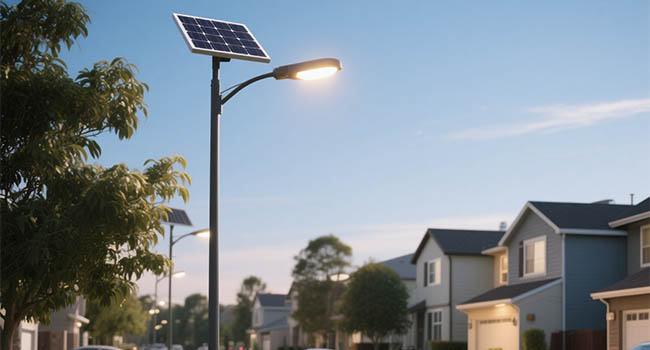
Price vs Value
Beware of the Potential Risks of Low-Price Traps for Projects
When selecting a solar street light manufacturer, price is an important consideration, but avoid the misconception that “low price equals good value.” Low-cost solar LED street lights often compromise on materials and craftsmanship—such as using low-efficiency panels and substandard lithium batteries. While initial procurement costs are low, frequent issues arise later: battery capacity may degrade by 50% within a year, core components may require replacement within two years, and maintenance costs surge significantly. Moreover, these low-cost products offer poor energy efficiency, potentially failing to meet lighting requirements and necessitating additional grid power supplementation. Over the long term, their total cost exceeds that of premium products.
A Scientific Strategy for Balancing Cost and Quality
Selecting a solar street light manufacturer requires striking a balance between cost and quality, with the core principle being “obtaining high-value products at a reasonable price.” For projects demanding high stability and longevity—such as municipal thoroughfares or scenic area solar LED lighting—prioritize quality and performance. Though initial costs may be slightly higher, these systems extend service life by 3-5 years, reduce maintenance costs by 50%, and deliver superior long-term ROI. Budget-constrained short-term projects, like temporary construction roads, may opt for cost-effective solutions while ensuring core components meet quality standards.
When selecting solar street light manufacturers, focus on six interconnected core characteristics: quality and reliability, customization options, energy efficiency, warranty and customer support, installation services, and price-to-value ratio. Different user groups may prioritize varying aspects—for instance, municipal purchasers emphasize quality, warranty, and energy efficiency. Comprehensive evaluation based on specific needs is essential to identify premium manufacturers, ensure project success, and lay the foundation for sustainable development.

